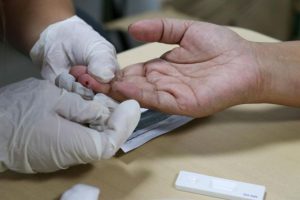Community Efforts are Key When Addressing HIV/AIDS
 1 Desember 2019
1 Desember 2019

Credit: WHO/ F. Tanggol.
By Ifeanyi Nsofor
ABUJA, Nov 30 2019 (IPS)
Three years ago, I led an evaluation of an HIV project that focused on increasing access to quality care and supporting services for people living with HIV in Nigeria. It also aimed to reduce HIV-related stigma and discrimination.
The project achieved these goals by strengthening support groups, using homebased care services for sick persons and providing Savings and Loans Association membership to improve the livelihoods of persons living with HIV. These outcomes point to the power of community in managing HIV.
The first of December is celebrated globally as World AIDS Day. The theme of the 2019 celebration is, “communities make the difference“. This reminds us to re-focus on the power of community as we try to end the HIV pandemic.
Based UNAIDS 2018 global data, 37.9 million people were living with HIV/AIDS. There were 1.7 million new HIV infections. Fifty-four percent of these new infections occurred among key populations such as men who have sex with men, transgender folks and sex workers.
The first of December is celebrated globally as World AIDS Day. The theme of the 2019 celebration is, “communities make the difference”. This reminds us to re-focus on the power of community as we try to end the HIV pandemic
The risk of acquiring HIV was 22 times higher among men who have sex with men; 22 times higher among people who inject drugs; 21 times higher for sex workers and 12 times higher for transgender people.
Weekly, about 6,000 young women aged 15–24 years become infected with HIV. In sub-Saharan Africa, 80% of new infections among adolescents aged 15–19 years are in girls. Young women aged 15–24 years are twice as likely to be living with HIV than men. Eighteen percent of pregnant women living with HIV did not have access to drugs that would prevent transmission of HIV to their newborns.
People living with HIV face many forms of discrimination when they try to get help. In Southwest Georgia in the U.S., people living with HIV travel long distances out of the area to access their HIV care for fear of being stigmatized.
In the United Arab Emirates, while citizens have free access to HIV treatment, non-nationals prisoners are denied HIV treatment and kept in isolation. However, some face more inequities than others. Key populations, adolescent girls and pregnant women are examples. These communities should be prioritized in the addressing HIV.
Here are four ways to bolster community efforts to ensure equity.
First, eliminate mother-to-child transmission of HIV through peer programs. Governments, UNAIDS and all partners working in HIV should draw lessons from a country such as Cuba that has eliminated mother-to-child transmission of HIV and Syphilis.
For instance, Cuba’s achievement is based on a universal healthcare system which integrates maternal and child health programs with programs for HIV and sexually transmitted infections. In addition, community of mothers living with HIV called Mentor Mothers can improve uptake of PMTCT services.
Mentor Mothers provide peer support to pregnant women who have HIV. A study in Zimbabwe showed that Mentor Mothers improved retention in PMTCT services and led to positive behaviour change among HIV-positive pregnant women.
Second, integrate HIV/AIDS programming into youth-friendly clinics that provide reproductive health services to women aged 15-24 years. These youth-friendly clinics should be safe spaces, non-judgmental and without discrimination.
South Africa has high burdens of women living with HIV -above 62% of adults living with HIV in South Africa are women, or 4.7 million people. In South Africa, mobile technology locally known as Ringa Nathi (talk to us in Zulu) is used to provide confidential youth-friendly HIV services through WhatsApp-based support groups of 10 youths.
It is a platform for judgement-free discussions while improving knowledge on importance of adherence to HIV treatment and living positively with HIV.
Third, prioritise HIV services for high-risk populations such as men who have sex with men, transgender people, sex workers and injection drug users. Too often, they face barriers and discrimination to receiving help and this must end.
In this light, South Africa has established its first transgender healthcare facility at the Wits Reproductive Health Institute.
In Malawi, a country with one of world’s highest HIV prevalence rates, sex workers are stigmatized and often experience violence. International NGO Médecins Sans Frontières (MSF) provides HIV counselling and testing services to sex workers.
Fourth, communities must protect the rights of high-risk populations, period. Throughout the 40 years of the HIV pandemic, these populations have faced discrimination and at times been removed from the mainstream of HIV programming.
Stringent homophobic laws across Africa prevent gay men from accessing life-saving antiretroviral drugs. A study of 45,000 gay men in 28 African countries including Kenya, Malawi and Nigeria found that only 25% were taking their HIV drugs.
Therefore, the courts must rise to the occasion and protect the rights of key populations. Consequently, a High Court in Zimbabwe recently ordered the Minister of Home Affairs and the police to pay a trans woman $400,000 as compensation for her unlawful arrest in 2004.
One key lesson I learnt from leading the evaluation of the HIV intervention in Nigeria is that, “If you want to go quickly, go alone. If you want to go far, go together”. Therefore, no community of people living with HIV should be left behind. However, to ensure equity, some communities should be brought to the same level as others and the journey continued.
The post Community Efforts are Key When Addressing HIV/AIDS appeared first on Inter Press Service.
Excerpt:
Dr. Ifeanyi Nsofor is a medical doctor, the CEO of EpiAFRIC, Director of Policy and Advocacy for Nigeria Health Watch
The post Community Efforts are Key When Addressing HIV/AIDS appeared first on Inter Press Service.
